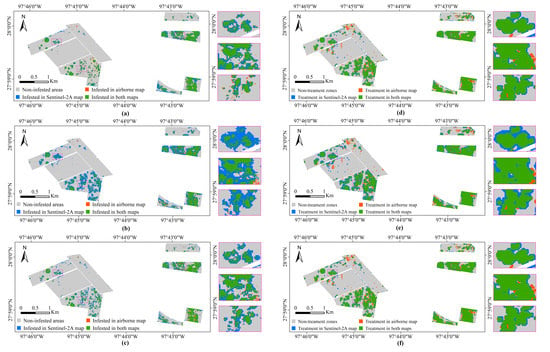Identification of Cotton Root Rot by Multifeature Selection from Sentinel-2 Images Using Random Forest
Abstract
1. Introduction
2. Materials and Methods
2.1. Study Area
2.2. Image Acquisition and Processing
2.2.1. Airborne Multispectral Imagery
2.2.2. Sentinel-2 Satellite Imagery
2.3. Methods
2.3.1. Spectral Characteristics Analysis
2.3.2. Extraction of Spectral Indices
2.3.3. Extraction of Texture Features
2.3.4. Selection of Optimal Spectral Indices and Texture Features
2.3.5. Binary Logistic Regression
2.3.6. Buffer Creation and Accuracy Assessment
3. Results
3.1. Selection of Optimal Spectral Indices and Texture Features for Identifying Cotton Root Rot
3.2. Binary Logistic Regression Models with Different Features
3.3. Classification Results and Accuracy Assessment
3.3.1. Airborne and Sentinel-2A Image Classification Results
3.3.2. Sentinel-2A Image Classification Accuracy Assessment
3.4. Feasibility for Creating Prescription Maps
4. Discussion
5. Conclusions
Author Contributions
Funding
Acknowledgments
Conflicts of Interest
References
- Yang, C.; Fernandez, C.J.; Everitt, J.H. Mapping Phymatotrichum root rot of cotton using airborne three-band digital imagery. Trans. ASAE 2005, 48, 1619–1626. [Google Scholar] [CrossRef]
- Song, X.; Yang, C.; Wu, M.; Zhao, C.; Yang, G.; Hoffmann, W.; Huang, W. Evaluation of Sentinel-2A satellite imagery for mapping cotton root rot. Remote Sens. 2017, 9, 906. [Google Scholar] [CrossRef]
- Yang, C.; Odvody, G.N.; Thomasson, J.A.; Isakeit, T.; Nichols, R.L. Change detection of cotton root rot infection over 10-year intervals using airborne multispectral imagery. Comput. Electron. Agric. 2016, 123, 154–162. [Google Scholar] [CrossRef]
- Yang, C.; Odvody, G.N.; Thomasson, J.A.; Isakeit, T.; Minzenmayer, R.R.; Drake, D.R.; Nichols, R.L. Site-specific management of cotton root rot using airborne and high-resolution satellite imagery and variable-rate technology. Trans. ASABE 2018, 61, 849–858. [Google Scholar] [CrossRef]
- Zheng, Q.; Huang, W.; Cui, X.; Dong, Y.; Shi, Y.; Ma, H.; Liu, L. Identification of wheat yellow rust using optimal three-band spectral indices in different growth stages. Sensors 2019, 19, 35. [Google Scholar] [CrossRef]
- Yang, C. Assessment of the severity of bacterial leaf blight in rice using canopy hyperspectral reflectance. Precis. Agric. 2010, 11, 61–81. [Google Scholar] [CrossRef]
- Huang, J.-F.; Apan, A. Detection of Sclerotinia rot disease on celery using hyperspectral data and partial least squares regression. J. Spat. Sci. 2006, 51, 129–142. [Google Scholar] [CrossRef][Green Version]
- Kumar, A.; Lee, W.S.; Ehsani, R.J.; Albrigo, L.G.; Yang, C.; Mangan, R.L. Citrus greening disease detection using aerial hyperspectral and multispectral imaging techniques. J. Appl. Remote Sens. 2012, 6, 063542. [Google Scholar] [CrossRef]
- Prabhakar, M.; Prasad, Y.G.; Desai, S.; Thirupathi, M.; Gopika, K.; Rao, G.R.; Venkateswarlu, B. Hyperspectral remote sensing of yellow mosaic severity and associated pigment losses in Vigna mungo using multinomial logistic regression models. Crop Prot. 2013, 45, 132–140. [Google Scholar] [CrossRef]
- Chen, B.; Li, S.; Wang, K.-R.; Wang, J.; Wang, F.-Y.; Xiao, C.-H.; Lai, J.-C.; Wang, N. Spectrum characteristics of cotton canopy infected with verticillium wilt and applications. Agric. Sci. China 2008, 7, 561–569. [Google Scholar] [CrossRef]
- Shi, Y.; Huang, W.; Luo, J.; Huang, L.; Zhou, X. Detection and discrimination of pests and diseases in winter wheat based on spectral indices and kernel discriminant analysis. Comput. Electron. Agric. 2017, 141, 171–180. [Google Scholar] [CrossRef]
- Zheng, Q.; Huang, W.; Cui, X.; Shi, Y.; Liu, L. New spectral index for detecting wheat yellow rust using sentinel-2 multispectral imagery. Sensors 2018, 18, 868. [Google Scholar] [CrossRef] [PubMed]
- De Castro, A.I.; Ehsani, R.; Ploetz, R.; Crane, J.H.; Abdulridha, J. Optimum spectral and geometric parameters for early detection of laurel wilt disease in avocado. Remote Sens. Environ. 2015, 171, 33–44. [Google Scholar] [CrossRef]
- Ye, H.; Huang, W.; Huang, S.; Cui, B.; Dong, Y.; Guo, A.; Ren, Y.; Jin, Y. Recognition of banana fusarium wilt based on UAV remote sensing. Remote Sens. 2020, 12, 938. [Google Scholar] [CrossRef]
- Yang, C.; Odvody, G.N.; Fernandez, C.J.; Landivar, J.A.; Thomasson, J.A. Monitoring cotton root rot progression within a growing season using airborne multispectral imagery. J. Cotton Sci. 2014, 18, 85–93. [Google Scholar]
- Yang, C.; Everitt, J.H.; Fernandez, C.J. Comparison of airborne multispectral and hyperspectral imagery for mapping cotton root rot. Biosyst. Eng. 2010, 107, 131–139. [Google Scholar] [CrossRef]
- Yang, C.; Odvody, G.N.; Fernandez, C.J.; Landivar, J.A.; Minzenmayer, R.R.; Nichols, R.L. Evaluating unsupervised and supervised image classification methods for mapping cotton root rot. Precis. Agric. 2015, 16, 201–215. [Google Scholar] [CrossRef]
- Wu, M.; Yang, C.; Song, X.; Hoffmann, W.C.; Huang, W.; Niu, Z.; Wang, C.; Li, W.; Yu, B. Monitoring cotton root rot by synthetic Sentinel-2 NDVI time series using improved spatial and temporal data fusion. Sci. Rep. UK 2018, 8, 2016. [Google Scholar] [CrossRef]
- Chakhar, A.; Ortega-Terol, D.; Hernández-López, D.; Ballesteros, R.; Ortega, J.F.; Moreno, M.A. Assessing the accuracy of multiple classification algorithms for crop classification using Landsat-8 and Sentinel-2 data. Remote Sens. 2020, 12, 1735. [Google Scholar] [CrossRef]
- Meyer, L.H.; Heurich, M.; Beudert, B.; Premier, J.; Pflugmacher, D. Comparison of landsat-8 and sentinel-2 data for estimation of leaf area index in temperate forests. Remote Sens. 2019, 11, 1160. [Google Scholar] [CrossRef]
- Ren, Y.; Meng, Y.; Huang, W.; Ye, H.; Han, Y.; Kong, W.; Zhou, X.; Cui, B.; Xing, N.; Guo, A.; et al. Novel vegetation indices for cotton boll opening status estimation using Sentinel-2 data. Remote Sens. 2020, 12, 1712. [Google Scholar] [CrossRef]
- Kaplan, G.; Avdan, U. Evaluating the utilization of the red edge and radar bands from sentinel sensors for wetland classification. Catena 2019, 178, 109–119. [Google Scholar] [CrossRef]
- Lin, S.; Li, J.; Liu, Q.; Li, L.; Zhao, J.; Yu, W. Evaluating the effectiveness of using vegetation indices based on red-edge reflectance from Sentinel-2 to estimate gross primary productivity. Remote Sens. 2019, 11, 1303. [Google Scholar] [CrossRef]
- Chemura, A.; Mutanga, O.; Dube, T. Separability of coffee leaf rust infection levels with machine learning methods at Sentinel-2 MSI spectral resolutions. Precis. Agric. 2017, 18, 859–881. [Google Scholar] [CrossRef]
- Fernández-Manso, A.; Fernández-Manso, O.; Quintano, C. Sentinel-2A red-edge spectral indices suitability for discriminating burn severity. Int. J. Appl. Earth Obs. 2016, 50, 170–175. [Google Scholar] [CrossRef]
- Murray, H.; Lucieer, A.; Williams, R. Texture-based classification of sub-Antarctic vegetation communities on Heard Island. Int. J. Appl. Earth Obs. 2010, 12, 138–149. [Google Scholar] [CrossRef]
- Zhang, G.; Jayas, D.S.; Jiang, D.; Zhang, Z. Grain classification with combined texture model. Trans. Chin. Soc. Agric. Eng. 2001, 17, 149–153. [Google Scholar]
- Yu, X.; Ge, H.; Lu, D.; Zhang, M.; Lai, Z.; Yao, R. Comparative study on variable selection approaches in establishment of remote sensing model for forest biomass estimation. Remote Sens. 2019, 11, 1437. [Google Scholar] [CrossRef]
- Dong, L.; Du, H.; Han, N.; Li, X.; Zhu, D.E.; Mao, F.; Zhang, M.; Zheng, J.; Liu, H.; Huang, Z.; et al. Application of convolutional neural network on lei bamboo above-ground-biomass (AGB) estimation using Worldview-2. Remote Sens. 2020, 12, 958. [Google Scholar] [CrossRef]
- Wu, L.; Xu, M.; Long, Q.; Tan, Y.; Kuang, J.; Liang, Z. A method of target detection for crop disease spots by improved Hough transform. Trans. Chin. Soc. Agric. Eng. 2014, 30, 152–159. [Google Scholar] [CrossRef]
- Zhang, L.; Liu, Z.; Ren, T.; Liu, D.; Ma, Z.; Tong, L.; Zhang, C.; Zhou, T.; Zhang, X.; Li, S. Identification of seed maize fields with high spatial resolution and multiple spectral remote sensing using random forest classifier. Remote Sens. 2020, 12, 362. [Google Scholar] [CrossRef]
- Guo, A.; Huang, W.; Ye, H.; Dong, Y.; Ma, H.; Ren, Y.; Ruan, C. Identification of wheat yellow rust using spectral and texture features of hyperspectral images. Remote Sens. 2020, 12, 1419. [Google Scholar] [CrossRef]
- Mahlein, A.; Oerke, E.; Steiner, U.; Dehne, H. Recent advances in sensing plant diseases for precision crop protection. Eur. J. Plant Pathol. 2012, 133, 197–209. [Google Scholar] [CrossRef]
- Biau, G. Analysis of a random forests model. J. Mach. Learn. Res. 2012, 13, 1063–1095. [Google Scholar] [CrossRef]
- Fletcher, R.S.; Reddy, K.N. Random forest and leaf multispectral reflectance data to differentiate three soybean varieties from two pigweeds. Comput. Electron. Agric. 2016, 128, 199–206. [Google Scholar] [CrossRef]
- Lee, S.; Pradhan, B. Landslide hazard mapping at Selangor, Malaysia using frequency ratio and logistic regression models. Landslides 2007, 4, 33–41. [Google Scholar] [CrossRef]
- Richards, J.A. Supervised classification techniques. In Remote Sensing Digital Image Analysis, 5th ed.; Springer: Berlin, Germany, 2013; pp. 247–318. [Google Scholar] [CrossRef]
- Schell, J.A. Monitoring vegetation systems in the great plains with ERTS. NASA Spec. Publ. 1973, 351, 309. [Google Scholar]
- Roujean, J.; Breon, F. Estimating PAR absorbed by vegetation from bidirectional reflectance measurements. Remote Sens. Environ. 1995, 51, 375–384. [Google Scholar] [CrossRef]
- Ceccato, P.; Flasse, S.; Tarantola, S.; Jacquemoud, S.; Grégoire, J. Detecting vegetation leaf water content using reflectance in the optical domain. Remote Sens. Environ. 2001, 77, 22–33. [Google Scholar] [CrossRef]
- Gao, B. NDWI—A normalized difference water index for remote sensing of vegetation liquid water from space. Remote Sens. Environ. 1996, 58, 257–266. [Google Scholar] [CrossRef]
- Chen, D.; Huang, J.; Jackson, T.J. Vegetation water content estimation for corn and soybeans using spectral indices derived from MODIS near-and short-wave infrared bands. Remote Sens. Environ. 2005, 98, 225–236. [Google Scholar] [CrossRef]
- Apan, A.; Held, A.; Phinn, S.; Markley, J. Detecting sugarcane ‘orange rust’ disease using EO-1 Hyperion hyperspectral imagery. Int. J. Remote Sens. 2010, 25, 489–498. [Google Scholar] [CrossRef]
- García, M.J.L.; Caselles, V. Mapping burns and natural reforestation using thematic Mapper data. Geocarto Int. 1991, 6, 31–37. [Google Scholar] [CrossRef]
- Merzlyak, M.N.; Chivkunova, O.B.; Gitelson, A.A.; Rakitin, V.Y. Non-destructive optical detection of pigment changes during leaf senescence and fruit ripening. Physiol. Plantarum. 2010, 106, 135–141. [Google Scholar] [CrossRef]
- Gitelson, A.A.; Gritz, Y.; Merzlyak, M.N. Relationships between leaf chlorophyll content and spectral reflectance and algorithms for non-destructive chlorophyll assessment in higher plant leaves. J. Plant Physiol. 2003, 160, 271–282. [Google Scholar] [CrossRef]
- Mahlein, A.K.; Rumpf, T.; Welke, P.; Dehne, H.W.; Plümer, L.; Steiner, U.; Oerke, E.C. Development of spectral indices for detecting and identifying plant diseases. Remote Sens. Environ. 2013, 128, 21–30. [Google Scholar] [CrossRef]
- Haralick, R.M.; Shanmugam, K.; Dinstein, I. Textural features for image classification. IEEE Trans. Syst. Man Cybern. 1973, 3, 610–621. [Google Scholar] [CrossRef]
- Jenson, S.; Waltz, F. Principal components analysis and canonical analysis in remote sensing. In Proceedings of the American Society of Photogrammetry, 45th Annual Meeting; American Society of Photogrammetry: Washington, DC, USA, 1979; Volume 1, pp. 337–348. [Google Scholar]
- Congalton, R.G. A review of assessing the accuracy of classifications of remotely sensed data. Remote Sens. Environ. 1991, 37, 35–46. [Google Scholar] [CrossRef]
- Foody, G.M. Classification accuracy comparison: Hypothesis tests and the use of confidence intervals in evaluations of difference, equivalence and non-inferiority. Remote Sens. Environ. 2009, 113, 1658–1663. [Google Scholar] [CrossRef]
- Yang, C. Remote sensing and precision agriculture technologies for crop disease detection and management with a practical application example. Engineering 2020, 6, 528–532. [Google Scholar] [CrossRef]
- Lu, J.; Zhou, M.; Gao, Y.; Jiang, H. Using hyperspectral imaging to discriminate yellow leaf curl disease in tomato leaves. Precis. Agric. 2018, 19, 379–394. [Google Scholar] [CrossRef]
- Zarco-Tejada, P.J.; Hornero, A.; Hernández-Clemente, R.; Beck, P.S.A. Understanding the temporal dimension of the red-edge spectral region for forest decline detection using high-resolution hyperspectral and Sentinel-2a imagery. ISPRS J. Photogramm. 2018, 137, 134–148. [Google Scholar] [CrossRef] [PubMed]
- Clevers, J.G.P.W.; Gitelson, A.A. Remote estimation of crop and grass chlorophyll and nitrogen content using red-edge bands on Sentinel-2 and-3. Int. J. Appl. Earth Obs. 2013, 23, 344–351. [Google Scholar] [CrossRef]
- Hill, M.J. Vegetation index suites as indicators of vegetation state in grassland and savanna: An analysis with simulated Sentinel-2 data for a north American transect. Remote Sens. Environ. 2013, 137, 94–111. [Google Scholar] [CrossRef]
- Ma, H.; Huang, W.; Jing, Y.; Pignatti, S.; Laneve, G.; Dong, Y.; Ye, H.; Liu, L.; Guo, A.; Jiang, J. Identification of fusarium head blight in winter wheat ears using continuous wavelet analysis. Sensors 2020, 20, 20. [Google Scholar] [CrossRef]
- Zhang, J.; Huang, Y.; Pu, R.; Gonzalez-Moreno, P.; Yuan, L.; Wu, K.; Huang, W. Monitoring plant diseases and pests through remote sensing technology: A review. Comput. Electron. Agric. 2019, 165, 104943. [Google Scholar] [CrossRef]
- Kakani, V.G.; Reddy, K.R.; Zhao, D. Deriving a simple spectral reflectance ratio to determine cotton leaf water potential. J. New Seeds 2007, 8, 11–27. [Google Scholar] [CrossRef]
- Zhang, J.; Yuan, L.; Pu, R.; Loraamm, R.W.; Yang, G.; Wang, J. Comparison between wavelet spectral features and conventional spectral features in detecting yellow rust for winter wheat. Comput. Electron. Agric. 2014, 100, 79–87. [Google Scholar] [CrossRef]
- Calderón, R.; Navas-Cortés, J.A.; Lucena, C.; Zarco-Tejada, P.J. High-resolution airborne hyperspectral and thermal imagery for early detection of Verticillium wilt of olive using fluorescence, temperature and narrow-band spectral indices. Remote Sens. Environ. 2013, 139, 231–245. [Google Scholar] [CrossRef]
- Jiang, R.; Tang, W.; Wu, X.; Fu, W. A random forest approach to the detection of epistatic interactions in case-control studies. BMC Bioinform. 2009, 10, S65. [Google Scholar] [CrossRef]
- Peña-Barragán, J.M.; Ngugi, M.K.; Plant, R.E.; Six, J. Object-based crop identification using multiple vegetation indices, textural features and crop phenology. Remote Sens. Environ. 2011, 115, 1301–1316. [Google Scholar] [CrossRef]
- Chen, D.; Stow, D.A.; Gong, P. Examining the effect of spatial resolution and texture window size on classification accuracy: An urban environment case. Int. J. Remote Sens. 2004, 25, 2177–2192. [Google Scholar] [CrossRef]
- Vasilakos, C.; Kavroudakis, D.; Georganta, A. Machine learning classification ensemble of multitemporal Sentinel-2 images: The case of a mixed mediterranean ecosystem. Remote Sens. 2020, 12, 2005. [Google Scholar] [CrossRef]
- Salas, E.A.L.; Subburayalu, S.K.; Slater, B.; Zhao, K.; Bhattacharya, B.; Tripathy, R.; Das, A.; Nigam, R.; Dave, R.; Parekh, P. Mapping crop types in fragmented arable landscapes using AVIRIS-NG imagery and limited field data. Int. J. Image Data Fusion 2020, 11, 33–56. [Google Scholar] [CrossRef]
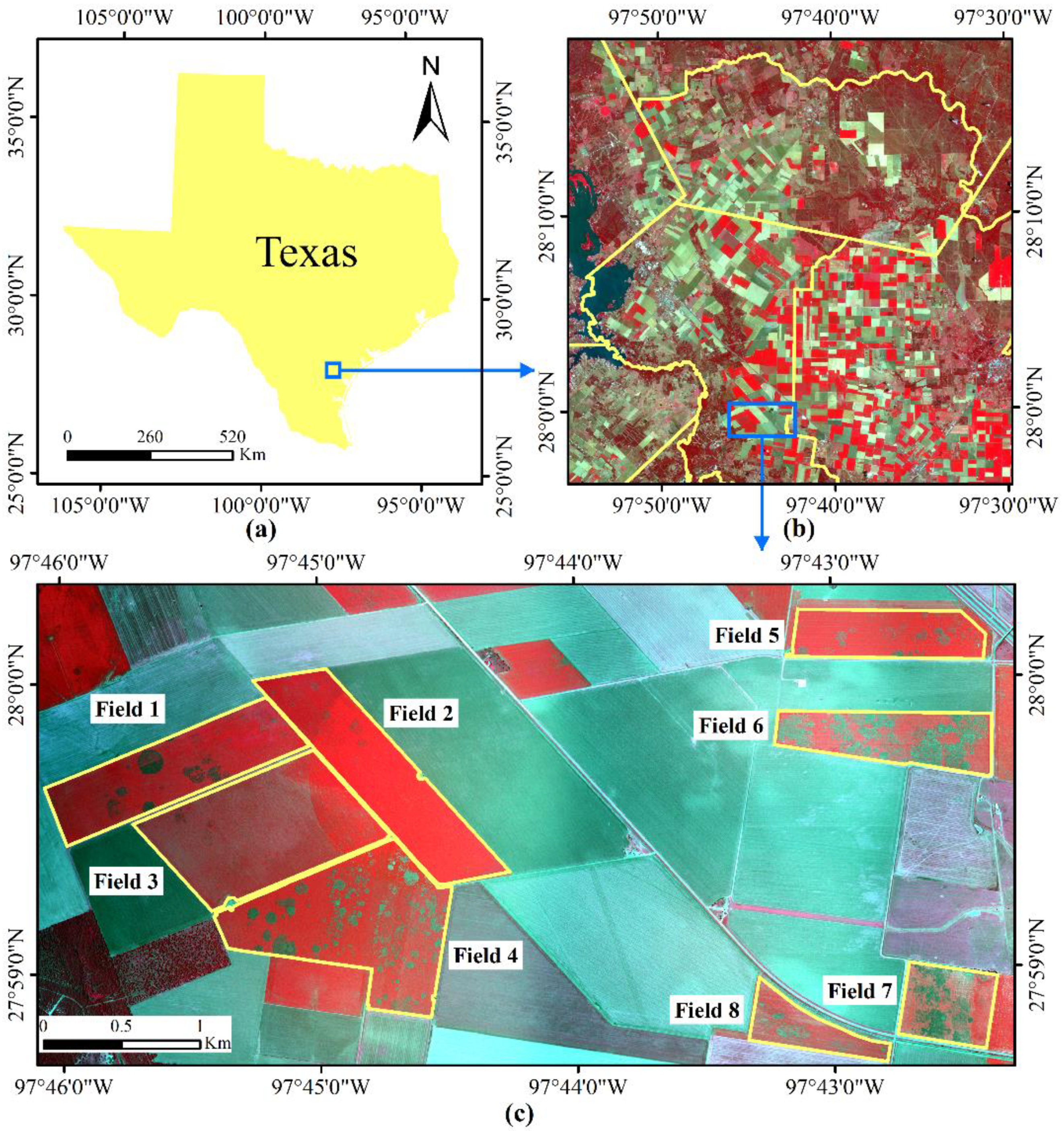

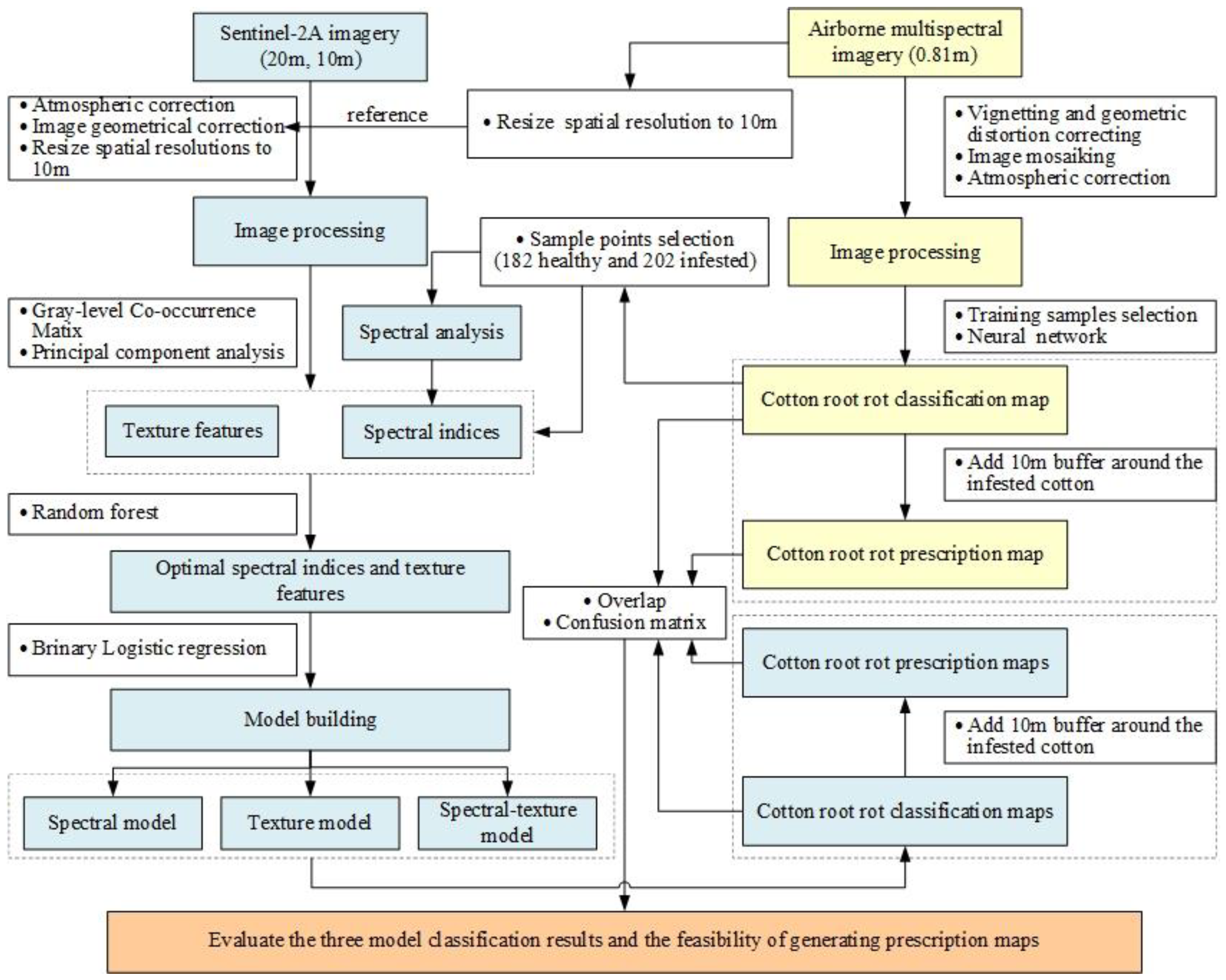

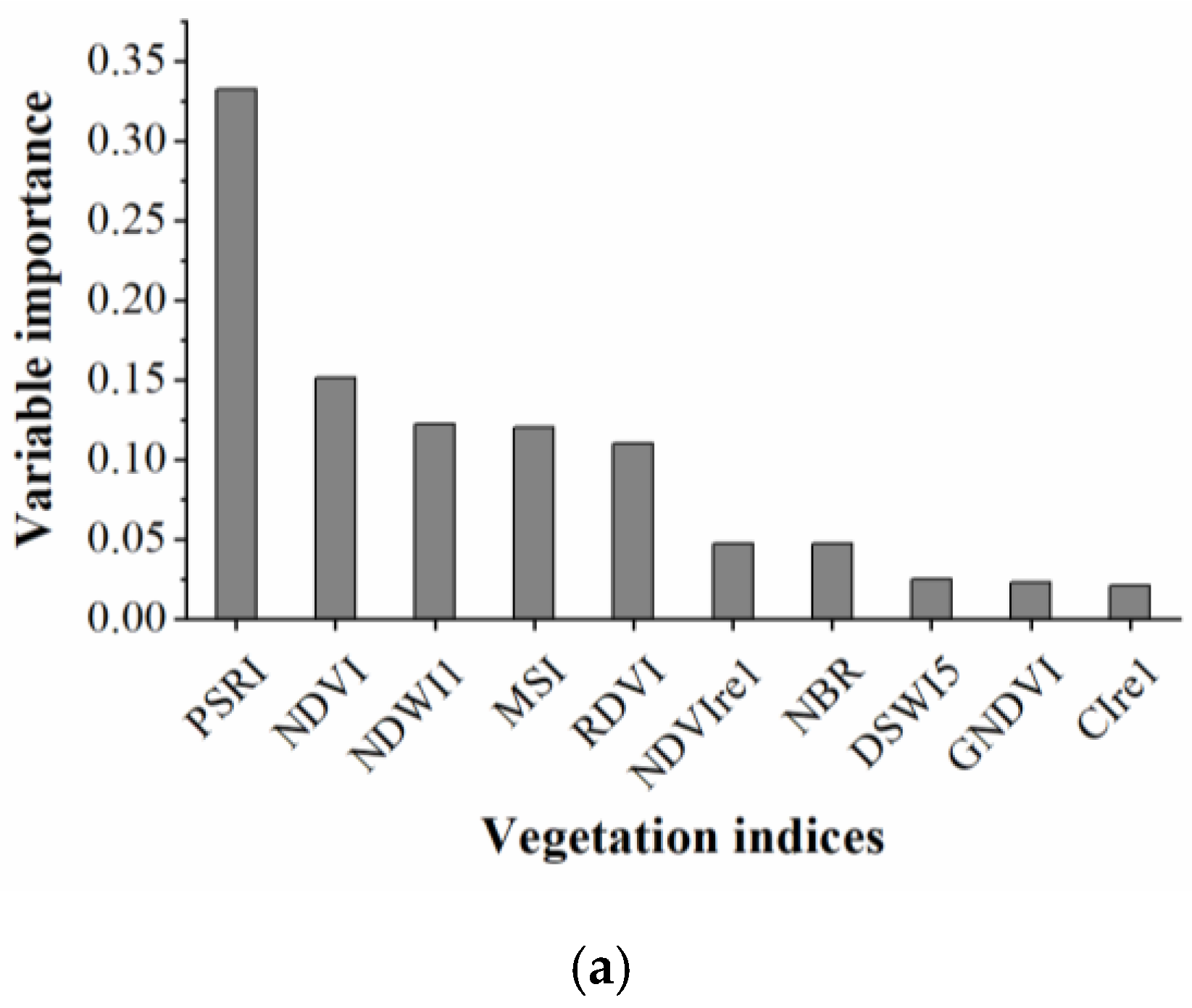
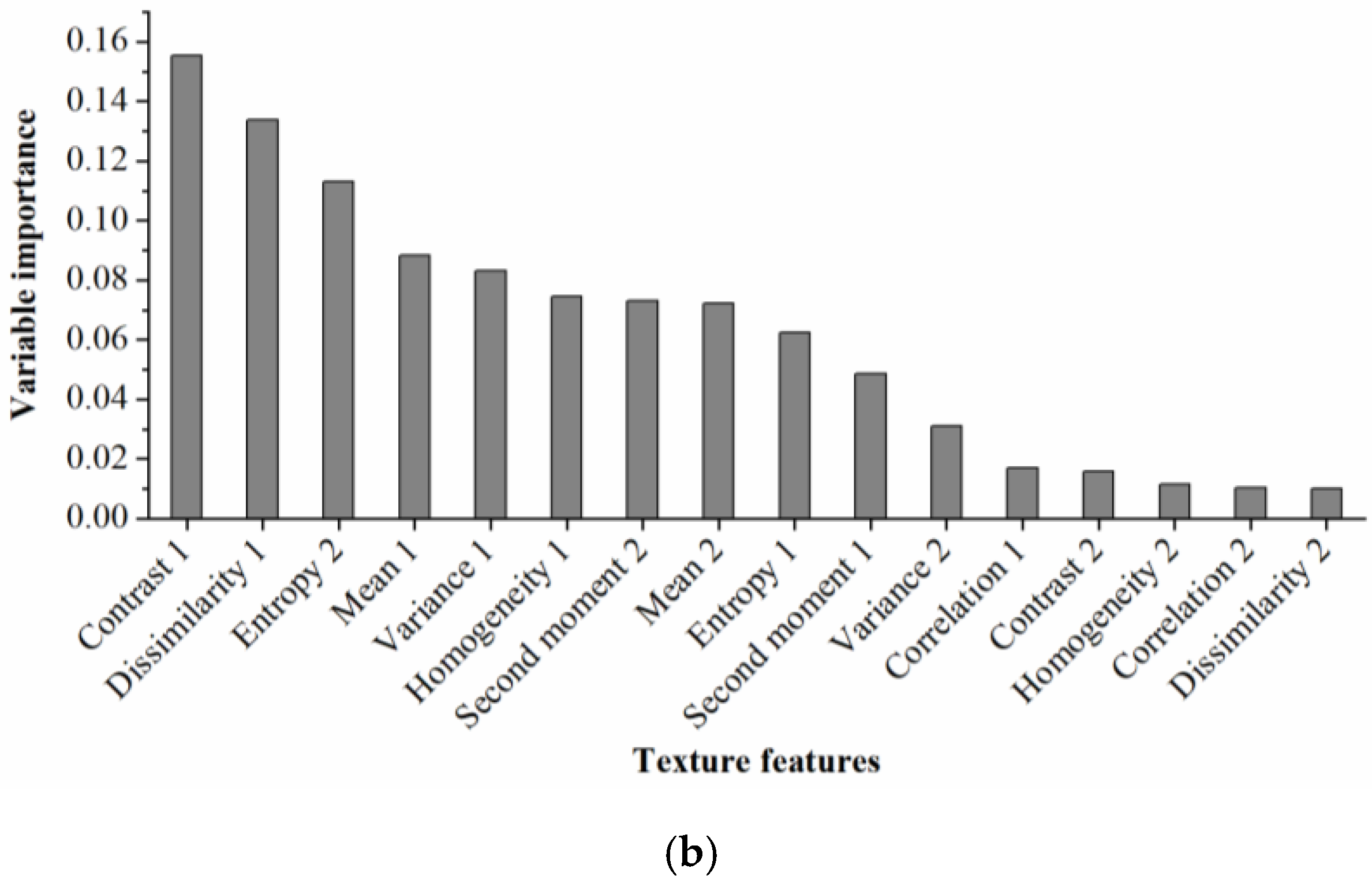

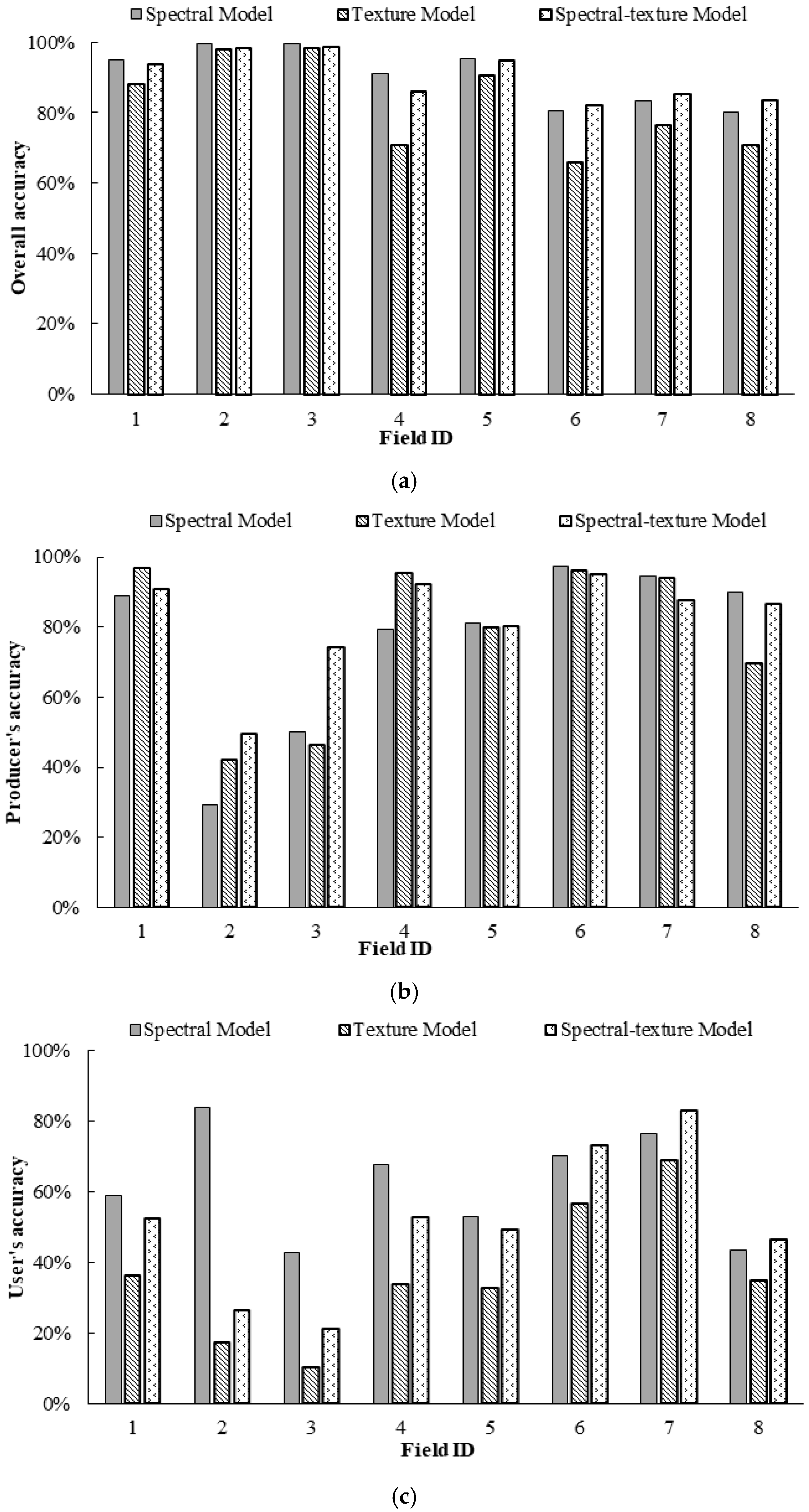
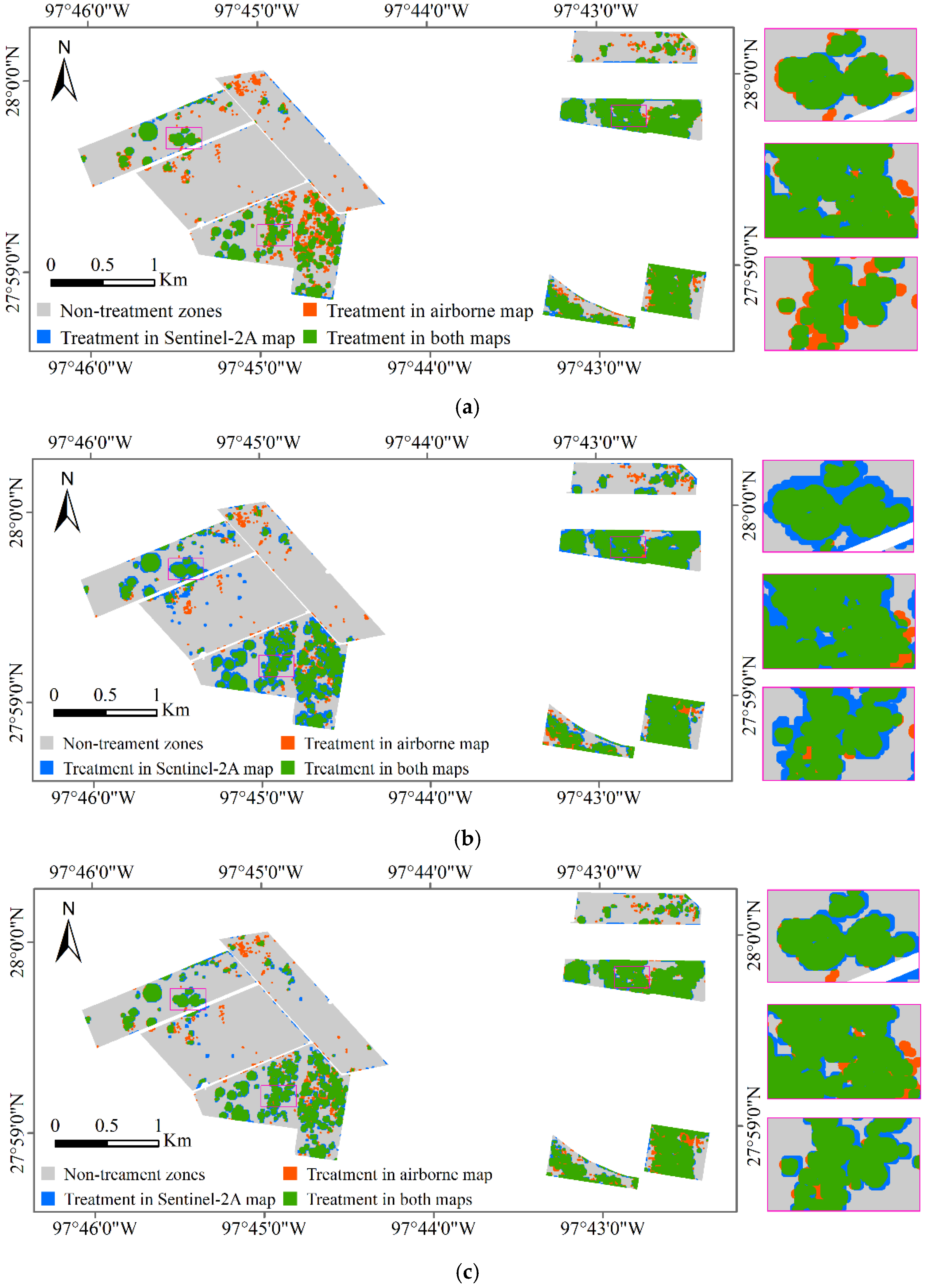
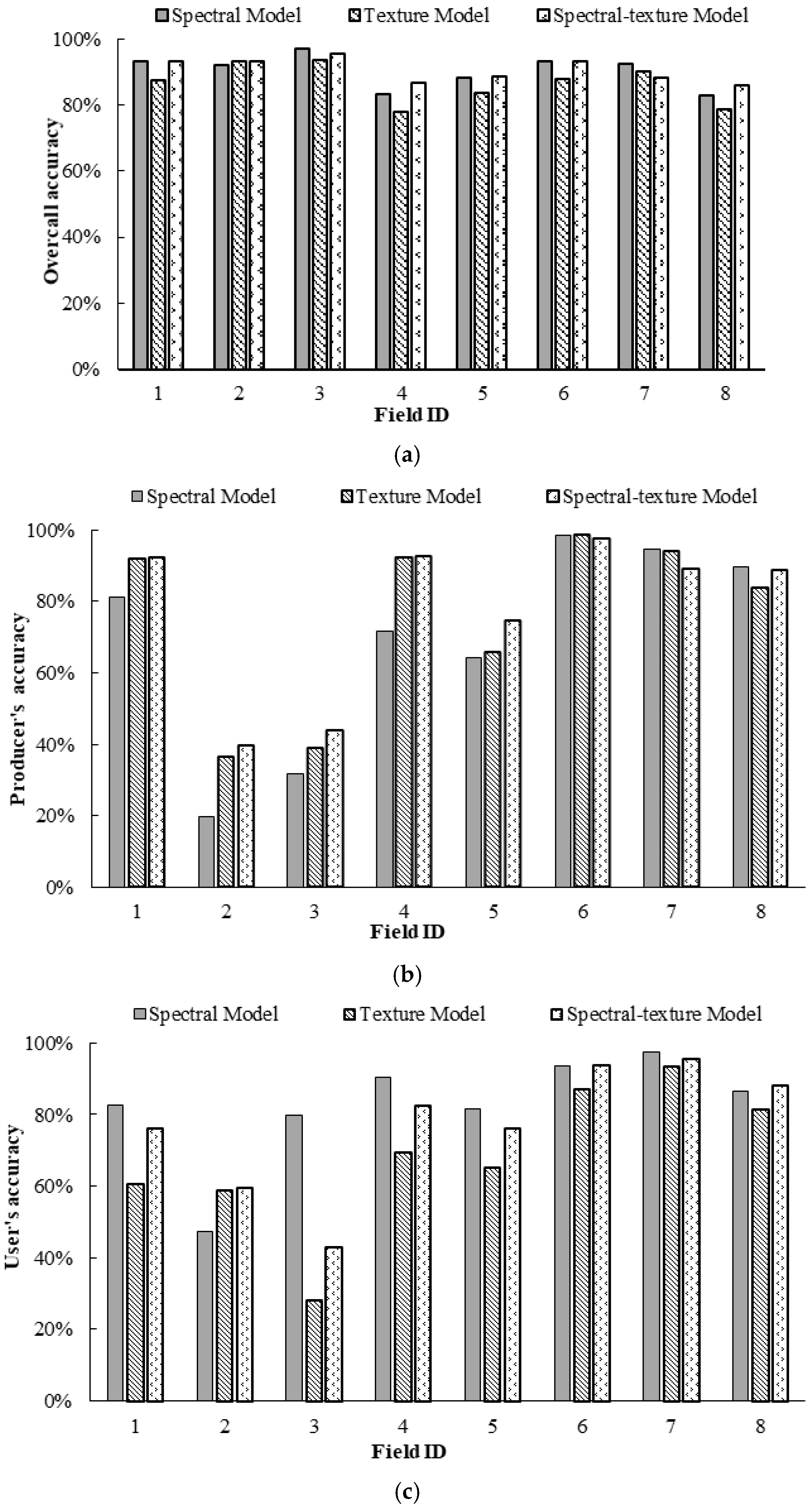
| Field ID | Healthy Cotton | Infested Cotton |
|---|---|---|
| 1 | 26 | 41 |
| 2 | 23 | 5 |
| 3 | 20 | 4 |
| 4 | 24 | 64 |
| 5 | 21 | 30 |
| 6 | 26 | 29 |
| 7 | 20 | 22 |
| 8 | 22 | 7 |
| Total | 182 | 202 |
| Spectral Indices | Calculation Formulas | Related to | Reference |
|---|---|---|---|
| Normalized Difference Vegetation Index (NDVI) | Vegetation status, canopy structure | [38] | |
| Renormalized Difference Vegetation Index (RDVI) | Canopy structure | [39] | |
| Green Normalized Difference Vegetation Index (GNDVI) | Canopy structure; pigment content | [24] | |
| Moisture Stressed Index (MSI) | Canopy water content | [40] | |
| Normalized Difference Water Index (NDWI1) | Canopy water content | [41,42] | |
| Disease Stress Water Index (DSWI5) | Canopy water content | [43] | |
| Normalized Burn Ratio (NBR) | Canopy water content | [42,44] | |
| Plant Senescence Reflectance Index (PSRI) | Pigment content; leaf senescence and ripening | [45] | |
| Normalized Difference Vegetation Index Red-edge 1 (NDVIre1) | Canopy foliage content; gap fraction; senescence. | [38] | |
| Chlorophyll Index Red-edge (CIre1) | Chlorophyll content | [46] |
| Regression Model | Variable | Regression Coefficient | Significant Level |
|---|---|---|---|
| Spectral | NDVI PSRI | 1.421 116.997 | 0.028 0.000 |
| Texture | Mean 1 Entropy 2 | −0.232 5.751 | 0.000 0.000 |
| Spectral-texture | NDWI1 RDVI Mean 1 Entropy 2 | 76.280 −221.940 1.313 6.747 | 0.009 0.003 0.006 0.001 |
| Regression Model | Training Set | Test Set | ||||||
|---|---|---|---|---|---|---|---|---|
| Acc (%) | Pre (%) | Rec (%) | F (%) | Acc (%) | Pre (%) | Rec (%) | F (%) | |
| Spectral | 95.96 | 96.53 | 95.21 | 95.86 | 93.10 | 100.00 | 89.29 | 94.34 |
| Texture | 95.62 | 95.24 | 95.89 | 95.56 | 90.80 | 98.00 | 87.50 | 92.45 |
| Spectral-texture | 98.65 | 99.30 | 97.94 | 98.62 | 96.55 | 100.00 | 94.64 | 97.25 |
| Field | Field Area | Cotton Root Rot-Infested Area | |||||||
|---|---|---|---|---|---|---|---|---|---|
| Airborne Image | Sentinel-2A Image | ||||||||
| Neural Network | Spectral Model | Texture Model | Spectral-Texture Model | ||||||
| m2 | m2 | % | m2 | % | m2 | % | m2 | % | |
| 1 | 628,265 | 42,548 | 6.77 | 63,919 | 10.17 | 113,130 | 18.01 | 73,327 | 11.67 |
| 2 | 693,875 | 5232 | 0.75 | 1827 | 0.26 | 12,636 | 1.82 | 9730 | 1.40 |
| 3 | 870,805 | 3038 | 0.35 | 3562 | 0.41 | 13,433 | 1.54 | 10,611 | 1.22 |
| 4 | 929,965 | 141,717 | 15.24 | 165,906 | 17.84 | 396,430 | 42.63 | 246,838 | 26.54 |
| 5 | 356,173 | 17,714 | 4.97 | 27,191 | 7.63 | 43,158 | 12.12 | 28,886 | 8.11 |
| 6 | 424,042 | 187,955 | 44.32 | 261,485 | 61.66 | 318,249 | 75.05 | 243,822 | 57.50 |
| 7 | 265,673 | 127,941 | 48.16 | 157,893 | 59.43 | 173,828 | 65.43 | 135,003 | 50.82 |
| 8 | 189,532 | 34,141 | 18.01 | 70,841 | 37.38 | 68,155 | 35.96 | 63,212 | 33.35 |
| Total | 4,358,330 | 560,286 | 12.86 | 752,623 | 17.27 | 1,139,019 | 26.13 | 811,428 | 18.62 |
| Model | Category | Actual Classification Area (m2) | UA | OA | ||
|---|---|---|---|---|---|---|
| Noninfested | Infested | Total | ||||
| Spectral | Noninfested | 3,548,172 | 57,534 | 3,605,706 | 98.40% | 92.95% |
| Infested | 249,872 | 502,752 | 7,522,624 | 66.80% | ||
| Total | 3,798,044 | 560,286 | 4,358,330 | |||
| PA | 93.42% | 89.73% | ||||
| Texture | Noninfested | 3,177,595 | 41,717 | 3,219,312 | 98.70% | 84.81% |
| Infested | 620,449 | 518,569 | 1,139,018 | 45.53% | ||
| Total | 3,798,044 | 560,286 | 4,358,330 | |||
| PA | 83.66% | 92.55% | ||||
| Spectral-texture | Noninfested | 3,495,409 | 51,491 | 3,546,900 | 98.55% | 91.87% |
| Infested | 302,635 | 508,795 | 811,430 | 62.70% | ||
| Total | 3,798,044 | 560,286 | 4,358,330 | |||
| PA | 92.03% | 90.80% | ||||
| Field | Treatment Area (m2) | |||||||
|---|---|---|---|---|---|---|---|---|
| Airborne Image | Sentinel-2A Image | |||||||
| Neural Network | Spectral Model | Texture Model | Spectral-Texture Model | |||||
| m2 | % | m2 | % | m2 | % | m2 | % | |
| 1 | 116,491 | 18.54 | 114,256 | 18.19 | 175,743 | 27.97 | 139,645 | 22.23 |
| 2 | 52,167 | 7.52 | 21,678 | 3.12 | 32,212 | 4.64 | 34,640 | 4.99 |
| 3 | 34,568 | 3.97 | 13,758 | 1.58 | 47,750 | 5.48 | 35,137 | 4.03 |
| 4 | 428,797 | 46.11 | 339,681 | 36.53 | 567,137 | 60.98 | 468,346 | 50.36 |
| 5 | 83,240 | 23.37 | 65,462 | 18.38 | 83,894 | 23.55 | 81,363 | 22.84 |
| 6 | 321,353 | 75.78 | 335,307 | 79.07 | 362,983 | 85.60 | 332,339 | 78.37 |
| 7 | 207,813 | 78.22 | 197,849 | 74.47 | 208,800 | 78.59 | 193,535 | 72.85 |
| 8 | 115,322 | 60.85 | 113,833 | 60.06 | 118,242 | 62.39 | 115,817 | 61.11 |
| Total | 1,359,752 | 31.20 | 1,201,822 | 27.58 | 1,596,761 | 36.64 | 1,400,823 | 32.14 |
| Model | Category | Prescription Area (m2) | UA | OA | ||
|---|---|---|---|---|---|---|
| Nontreatment | Treatment | Total | ||||
| Spectral | Nontreatment | 2,877,719 | 278,789 | 3,156,508 | 91.17% | 90.83% |
| Treatment | 120,858 | 1,080,964 | 1,201,822 | 89.94% | ||
| Total | 2,998,577 | 1,359,753 | 4,358,330 | |||
| PA | 95.97% | 79.50% | ||||
| Texture | Nontreatment | 2,599,780 | 161,789 | 2,761,569 | 94.14% | 87.14% |
| Treatment | 398,756 | 1,198,005 | 1,596,761 | 75.03% | ||
| Total | 2,998,536 | 1,359,794 | 4,358,330 | |||
| PA | 86.70% | 88.10% | ||||
| Spectral-texture | Nontreatment | 2,790,556 | 166,951 | 2,957,507 | 94.36% | 91.40% |
| Treatment | 208,022 | 1,192,801 | 1,400,823 | 85.15% | ||
| Total | 2,998,578 | 1,359,752 | 4,358,330 | |||
| PA | 93.06% | 87.72% | ||||
Publisher’s Note: MDPI stays neutral with regard to jurisdictional claims in published maps and institutional affiliations. |
© 2020 by the authors. Licensee MDPI, Basel, Switzerland. This article is an open access article distributed under the terms and conditions of the Creative Commons Attribution (CC BY) license (http://creativecommons.org/licenses/by/4.0/).
Share and Cite
Li, X.; Yang, C.; Huang, W.; Tang, J.; Tian, Y.; Zhang, Q. Identification of Cotton Root Rot by Multifeature Selection from Sentinel-2 Images Using Random Forest. Remote Sens. 2020, 12, 3504. https://doi.org/10.3390/rs12213504
Li X, Yang C, Huang W, Tang J, Tian Y, Zhang Q. Identification of Cotton Root Rot by Multifeature Selection from Sentinel-2 Images Using Random Forest. Remote Sensing. 2020; 12(21):3504. https://doi.org/10.3390/rs12213504
Chicago/Turabian StyleLi, Xingrong, Chenghai Yang, Wenjiang Huang, Jia Tang, Yanqin Tian, and Qing Zhang. 2020. "Identification of Cotton Root Rot by Multifeature Selection from Sentinel-2 Images Using Random Forest" Remote Sensing 12, no. 21: 3504. https://doi.org/10.3390/rs12213504
APA StyleLi, X., Yang, C., Huang, W., Tang, J., Tian, Y., & Zhang, Q. (2020). Identification of Cotton Root Rot by Multifeature Selection from Sentinel-2 Images Using Random Forest. Remote Sensing, 12(21), 3504. https://doi.org/10.3390/rs12213504





